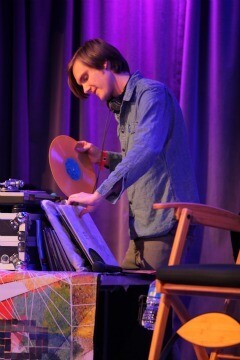With our free press under threat and federal funding for public media gone, your support matters more than ever. Help keep the LAist newsroom strong, become a monthly member or increase your support today during our fall member drive.
This archival content was written, edited, and published prior to LAist's acquisition by its current owner, Southern California Public Radio ("SCPR"). Content, such as language choice and subject matter, in archival articles therefore may not align with SCPR's current editorial standards. To learn more about those standards and why we make this distinction, please click here.
Top 10 Things You Didn't Know About Making A Record

Full disclosure: I'm not a vinyl nerd. I just like lectures with people who are passionate about their work.
Last night, a crowd of vinyl nerds, fledgling record labels and artists looking to self-produce packed the Grammy Museum for a free panel discussion called From Vision to Vinyl: A Step-by-Step Look At Album Production hosted byDublab. The panel, selected by Origami Vinyl owner Neil Shield, was composed of people who helped him put out his first record. They included Pete Lyman ofInfrasonic Sound, a recording studio and CD/vinyl mastering suite, Kevin Smith of Bill Smith Custom Records, a pressing plant in El Segundo, Jennifer Freund of Dorado Press, that specializes in album covers and jackets, and Peanut Butter Wolf, a DJ and founder of Stones Throw Records.
From the mastering to the pressing to the album art, these were the people to turn to if you wanted to put out a record, and they offered a comprehensive, step by step instruction on how to do it yourself. Each of them was very passionate about their part of the process lovingly describing each step in jargon that I had never heard of. However, from what I did glean I comprised this list.
Here are the Top 10 Things You Didn't Know About Vinyl.
1. Mastering for a record is not the same as mastering for a CD. Apparently there are some sounds that cut too deeply and cause the record to skip if you use the original mastering or just sound awful on an LP. Sometimes a lot of the mastering need to be redone.
2. Analog recording equipment is not necessary for producing a record. Nor is it necessarily superior in sound quality, digital can be just as good.

Frosty McNeill of DubLab spinning before the panel. (Photo: Rowan Byers/LAist)
3. There is a difference in sound quality between clear and colored vinyl compared to the traditional black. The clear or colored vinyl tends to acquire more surface noise (pops and crackles) over time.4. There are trade secrets in the pressing of records. The quality and quantity of materials are constantly being tested to produce a better sound. All pressing plants don't use the same formula.
5. The weight of the record has nearly nothing to do with the sound quality. Unless you have a very expensive stereo, the difference between 140-150g and 180-200g record is pretty small.
6. Giant quantities are not a necessity. Some pressing plants allow you to press 100- 500 records and then come back for more.
7. Art needs to be considered while pressing the record. Apparently, most pressing plants won't begin work until after the sleeves and album art is decided on, so they have somewhere to put the records. Decide on your art while you're mastering.
8. Vinyl now is far more durable than the vinyl that was being made in the 1960s because of the materials being used. They're also trying to go green by taking the lead out of the formulas.
9. There are all sorts of types of vinyl that can be pressed including a record that can be played from the inside out. The needle starts in the middle and then loops endlessly when it reaches the edge of the record.
10. Making records is expensive. 500 records would set you back around $2,000 to $3,000. For a lot of young artists it may be better to put out singles before deciding on a full LP.
To watch the whole panel, Dublab has kindly put it up on their website. For fledgling record labels and artists looking to put out vinyl it's essential. I also highly recommend it for the average music geek. It will give you a new sense of appreciation for your old vinyl collection.
At LAist, we believe in journalism without censorship and the right of a free press to speak truth to those in power. Our hard-hitting watchdog reporting on local government, climate, and the ongoing housing and homelessness crisis is trustworthy, independent and freely accessible to everyone thanks to the support of readers like you.
But the game has changed: Congress voted to eliminate funding for public media across the country. Here at LAist that means a loss of $1.7 million in our budget every year. We want to assure you that despite growing threats to free press and free speech, LAist will remain a voice you know and trust. Speaking frankly, the amount of reader support we receive will help determine how strong of a newsroom we are going forward to cover the important news in our community.
We’re asking you to stand up for independent reporting that will not be silenced. With more individuals like you supporting this public service, we can continue to provide essential coverage for Southern Californians that you can’t find anywhere else. Become a monthly member today to help sustain this mission.
Thank you for your generous support and belief in the value of independent news.

-
Restaurants share resources in the food hall in West Adams as Los Angeles reckons with increasing restaurant closures.
-
It will be the second national day of protest against President Donald Trump.
-
The university says the compact, as the Trump administration called it, could undermine free inquiry and academic excellence.
-
This is the one time you can do this legally!
-
Metro officials said it will be able to announce an opening date “soon.”
-
While working for the county, the DA’s office alleges that 13 employees fraudulently filed for unemployment, claiming to earn less than $600 a week.







